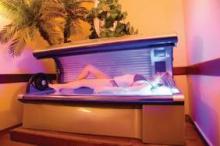Indoor tanning is strongly associated with the development of both basal and squamous cell carcinoma, according to a recent meta-analysis.
Indoor tanning – the use of a sun bed, sun lamp, tanning booth, or solarium – was related to a 29% higher risk for basal cell carcinoma and a 67% higher risk for squamous cell carcinoma, compared with no such exposure, according to a meta-analysis of 12 studies that reported effect estimates.
This translates to nearly 171,000 cases of nonmelanoma skin cancer each year that are attributable to indoor tanning in the United States alone, reported Mackenzie R. Wehner, a medical student at Stanford (Calif.) University, and her associates.
Several studies have examined a potential link between indoor tanning and nonmelanoma skin cancers, but the study populations have been small and the results have not been consistent. Therefore, Ms. Wehner and her colleagues performed a systematic review and meta-analysis of 10 case-control studies, 1 nested case-control study, and 1 cohort study for a combined population of 80,661 patients, in which there were 9,328 cases of nonmelanoma skin cancer. The studies were conducted in six countries from 1985 to 2012.
The investigators found summary relative risks of 1.29 for basal cell carcinoma and 1.67 for squamous cell carcinoma. These findings did not change appreciably in sensitivity analyses (BMJ 2012;345:e5909 [doi:10.1136/bmj.e5909]).
To examine whether a dose-response effect was present, the researchers performed an additional analysis on the studies that included effect estimates for frequent or multiple exposures to indoor tanning. Such high-dose exposure was associated with an increased risk of basal cell carcinoma, but the increase was not statistically significant.
To examine whether exposure to indoor tanning at a young age was especially high risk, Ms. Wehner and her colleagues performed an additional analysis of studies that included effect estimates for exposure before age 25. They found that such exposure was associated with a relative risk of 1.40 for basal cell carcinoma and of 2.02 for squamous cell carcinoma. "This suggests a critical period for exposure during early life," they wrote.
"Applying our summary risk estimates to the prevalence of exposure to indoor tanning in the United States, we calculated the population attributable risk fraction at 3.7% for basal cell carcinoma and at 8.2% for squamous cell carcinoma. This corresponds to 98,408 cases of basal cell carcinoma and 72,244 cases of squamous cell carcinoma, making 170,652 cases of nonmelanoma skin cancer each year attributable to indoor tanning," the researchers noted.
The study results are consistent with those of a previous meta-analysis that pooled the results of five studies. "Our findings add to the growing body of evidence on the harms of indoor tanning," Ms. Wehner and her colleagues said. "We hope that these findings can support public health campaigns and motivate increased regulation to reduce exposure to this carcinogen, especially during early life."
The study was supported by the National Center for Research Resources and the National Institute of Arthritis and Musculoskeletal and Skin Diseases. One of the study investigators reported ties to Genentech. No other conflicts of interest were reported.


